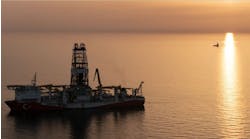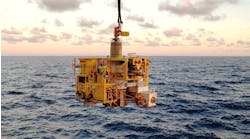Ultra-deepwater exploration full of surprises
As the leading deepwater producer in the Gulf of Mexico, Shell Exploration & Production Co. is pioneering the way to the ultra-deepwater.
In 2005, Shell plans to drill 12 “big cat” exploration and development wells worldwide. Big cat wells are those greater than 100 MMboe Shell equity share. The big cats are in various plays, including one on the deep shelf off the Texas Gulf coast. But in the deepwater, Shell is exploring the Miocene subsalt play. The company is drilling one well there now and has plans to drill or participate in four more this year.
Shell has been operating in the GoM for over 50 years and holds 723 leases, which makes the company one of the largest leaseholders in the Gulf. More than 80% of these leases are in deepwater.
The company brought its first deepwater well (greater than 1,000 ft water depth), Bullwinkle, online in 1988. Since then, it has added about 30 deepwater discoveries to its list and set numerous deepwater records for platforms and subsea production systems.
Recently, Shell has focused most of its exploration in water depths greater than 1,500 ft.
The biggest challenge the company faces in ultra-deepwater exploration is seeing below the salt. Shell uses standard seismic technology in conjunction with pre-stack depth migration (PSDM).
“As the seismic is acquired, the regular processing stream does not image the sediments below the salt,” says Annell Bay, regional exploration director, Shell EP in the Americas. “The PSDM gives us an improved image. Once we have that image, we know what we want to drill.”
Once Shell drills to the salt, it faces several challenges in terms of pressure and temperature differentials. Seismic and velocity data as well as other data to calculate pore pressure help Bay and her team predict where they will encounter problems. Shell also looks to other wells drilled in the area for clues on what to expect.
“The challenge is drilling in and out of zones of varying pressures. The problem is going from a higher pressure to a lower pressure section or vice versa. We have to set casing across the higher pressure areas before drilling into lower pressure sections to maintain well hole integrity and safety. We use weighted drilling mud to hold back the formation while drilling, and the mud weight must be in or near balance with the formation pressure, or there are problems within the well bore. We don’t want problems, so we constantly monitor pressure changes and adjust the drilling mud weight accordingly,” Bay explains.
Great White is the company’s latest discovery, made in May 2002. It is in over 8,000 ft of water in Alaminos Canyon block 857 in the Perdido foldbelt trend, which involves Mesozoic through Miocene strata and covers an area of 20,000 sq km.
“We’ve drilled five exploration and appraisal wells in the Great White area,” Bay says. “We are in the system selection phase where we determine what size facility and system capacity we need to match what we think will be the production rates.”
Shell is taking more time than previous deepwater discoveries to bring Great White online because of the challenges it faces in drilling in ultra-deepwater.
“In deeper sediments, there are challenges in reservoir quality, and that effects how oil and gas will flow from rocks. The sediments under the salt may have better reservoir quality or ability to flow hydrocarbons than those sediments at the same depth not below salt. So the salt may be protecting the quality of potential reservoirs. This is why it is so important to be able to image the opportunities under salt in the first place,” Bay says.
Exploring and developing in the ultra-deepwater GoM takes careful testing and analysis, which can take years. But as industry explores more and finds ways to overcome these challenges, the time will diminish, just as it did on the shelf.
“Shell’s future in the GoM has changed in the last five years in terms of exploration,” Bay says. Industry has drilled a lot of the shallow plays, and Shell is looking deeper for more opportunities.
“It is more complex than just drilling deeper. The challenges under salt require more detailed well planning than in the past,” Bay says. “There is incredible potential out there, and Shell intends to remain very active in it.”•




